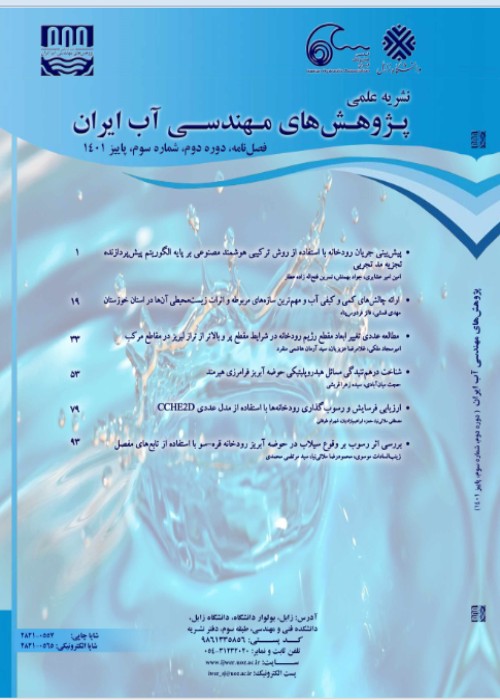Scouring around the middle-square pier of the bridge due to the change in abutment length and vegetation in the floodplain, a laboratory study
Scouring is the erosion around structures that occurs due to complex eddy currents and creates a pit around the supporting foundations of structures (Melville, 1997). Depth of scour plays a vital role in 1) the degree of the potential destruction of flow around the structure and 2) designing the dimensions of the foundation of structures in the path of water flow. Therefore, determining the mathematical relationship between scour depth and affecting parameters (Barbhuiya and Dey, 2004) and understanding the scour mechanism around bridge piers, and accurately estimating scour depth for more and better protection of bridge piers against this phenomenon (Breusers et al ., 1997) is of great importance. Numerous comprehensive studies have been performed since 1953 to identify the effect of various factors on scouring rate and determine its estimation methods (Laursen and Toch, 1953; Shen et al., 1966; Garde and Ranga-Raju, 1985; Melville, 1995).To date, researchers have studied the effect of geometric and hydraulic parameters (Sturm and Sadiq, 1996; Kouchakzadeh and Townsend, 2000; Jordanova and James, 2003) and effective vegetation Young et al., 1993; Amir et al., 2018) on scouring, but the simultaneous effect of changing the length of abutments and vegetation on the amount of middle pier scour has been less considered. Therefore, in this study, the amount of scour around the middle pier of the bridge in compound sections in case of simultaneous change of abutment length and vegetation has been investigated.
Normalized parameters significantly deepen the understanding of various physical phenomena and allow the results of limited experiments to be applied to different situations. In this study, the maximum scour depth was selected as the primary variable and expressed as equation (1) in terms of effective parameters. Then, considering the parameters as iterative variables, using Buckingham p-theorem, equation (1) was written as a dimensionless relation (2). Because the amount of channel slope, unit weight of sediments, uniformity coefficient and average diameter of materials, velocity and depth of flow, and length of bridge pier are constant in all tests; normalized parameters and Froude number were removed. By simplifying and combining other parameters, dimensionless relations for degree of scour depth and volume were obtained as equations (3) and (4).A trapezoidal laboratory channel made at the Water Research Institute, Fig. 1, was used for the experiments. The central pier of the bridge around which the scour was examined has a square cross-section with sides of 4 cm. Abutments on both sides of the channel were provided in 8, 16, and 24 cm sizes. Vegetation was studied using non-submerged cylinders in diameter and length of 1 and 20 cm respectively applied in rows in areas of 1, 2, and 4% of the floodplain area. Fig. 2 shows the image of the laboratory channel. Experiments were performed in two time intervals of 3 and 8 hours to obtain equilibrium time and maximum scouring.
A total of 9 experiments were performed in which the depth and volume of scouring were determined. To name each experiment, the vegetation and abutment length were marked respectively with V and A. For example, V%1A80 refers to an experiment with 1% vegetation and an abutment of 80 mm length.Fig. 3 shows the changes in the longitudinal profile of the bed after scouring in different conditions of vegetation and the length of the abutment. Increase in the abutment length increased the height of material accumulation in all experiments. Increasing the percentage of vegetation leads to an increase in the volume of material accumulation in all samples due to increased bed roughness and turbulence of the flow and enlargement of the scour cavity. Also, it is observed that with increasing the percentage of vegetation and the length of the abutment, the length of scouring (after the hole in the direction of flow) increases.Fig. 4 shows that the depth and volume of scouring increases with increasing vegetation percentage. The highest scour volume occurred in 4% vegetation (the densest vegetation condition studied), which results in 9.2 cm and 7031 cm3 for experiments V%4A160 and V%4A240, respectively. The lowest scour depth and volume values were related to 1% vegetation and V%1A80 test, which are 4.1 cm and 766 cm3, respectively. Increasing the vegetation from 1 to 2% and from 2 to 4%, the scour depth at the pier of the bridge (with length and width 4 cm and 8 cm abutment length) increases by 14 and 57%, respectively, i.e., the scour volume, respectively increases 3.2. And 1.9 times.As the relative length of the abutment increases, the rate of deflection and the intensity of the flow in the main channel increase, after which the amount of scouring around the middle pier increases. As the percentage of vegetation in the floodplain becomes denser, the bed roughness increases, and the flow rate in the main channel increases, causing more scouring around the middle pier of the bridge (Figs. 5 and 6).
This study investigates the effect of flood vegetation and abutment length on the scouring depth and volume in a compound channel. This study shows that with increasing the percentage of vegetation, the scour depth at the pier of the bridge increases, and with increasing the length of the bridge abutment, the depth and volume of the scour increases. By the way, vegetation and abutment length percentages are the most influential parameters in creating scour depth and volume in which the former has more effect.
- حق عضویت دریافتی صرف حمایت از نشریات عضو و نگهداری، تکمیل و توسعه مگیران میشود.
- پرداخت حق اشتراک و دانلود مقالات اجازه بازنشر آن در سایر رسانههای چاپی و دیجیتال را به کاربر نمیدهد.



